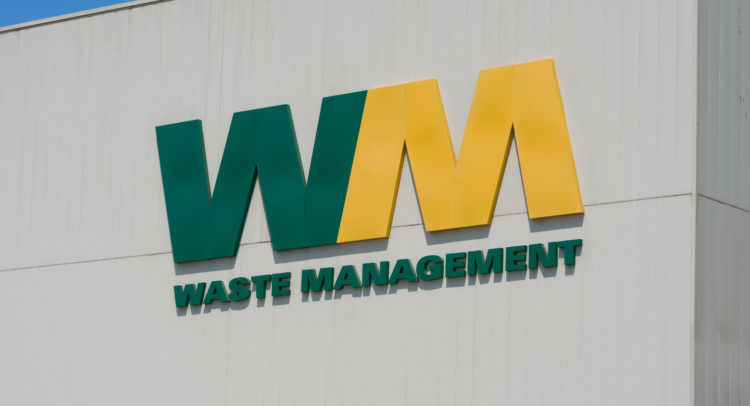Due to a combination of strong financial performance and operations within a durable, defensive industry, Waste Management (WM) has attracted a lot of investors’ attention. While the company possesses many desirable attributes, its valuation seems to be somewhat out of sync with the mature life stage of both the firm and the industry.
Discover the Best Stocks and Maximize Your Portfolio:
- See what stocks are receiving strong buy ratings from top-rated analysts.
- Filter, analyze, and streamline your search for investment opportunities with TipRanks’ Stock Screener.
In a very turbulent year for stocks, where the S&P 500 (SPX) is down about 15% year-to-date, WM stock has charted its own course. Seen widely as a defensive play in a turbulent market, the stock is slightly up on the year.

A Much Needed, Mature Industry
The waste solutions industry is rather mature, and it is expected to grow at a 3.4% compound annual growth rate (CAGR) until 2030. Primary growth drivers include environmental government measures that aim to increase sustainability. In addition, recycling services should also exhibit good growth potential, given consumers’ growing environmental awareness.
Other factors affecting industry performance include population and urbanization trends as well as levels of industrial production. Labor, transportation, and equipment costs, on the other hand, make the list of factors that can hamper industry growth.
The industry is very capital-intensive, and companies depend on the creation of economies of scale in order to achieve profitability. As a result, barriers to entry are high, and market leaders are likely to exhibit higher margins and cost efficiency.
A Durable Business Model
Through its subsidiaries, WM offers comprehensive waste management environmental services across the United States and Canada. The company serves a broad customer base that includes residential, commercial, and industrial clients while offering services at each stage of the collection and disposal process.
WM is also well-positioned (it’s the largest recycler in North America) in an economy that values sustainability while continuing to innovate toward environmentally-friendly solutions. WM currently operates 49 Materials Recovery facilities (recycling plants), and Recycling Services represent 8% of total revenue.
Reinforcing its industry leadership position, WM controls a vast operational network consisting of 260 active landfills, 340 transfer facilities, 15,500 collection routes, 550 collection sites, and 96 materials recovery facilities. Given the capital-intensive nature of the waste solutions industry, competitors will find reproducing Waste Management’s economies of scale very challenging. It is, therefore, safe to assume that the competitive edge the company maintains is likely to solidify over the next years.
Even as Waste Management’s business sees some fluctuation with changes in industrial output and activity, the essential nature of waste collection and processing services allows for predictable cash flows, especially considering that 75% of WM’s revenue is recurring in nature. Constant innovation and technological advances also assist in further operational cost reductions.
Waste Management’s Financial Performance Remains Strong
Using its predictable revenue streams as a foundation, Waste Management has managed to increase its top line by a CAGR of 6.1% since 2017, while growth has somewhat accelerated as of recently, reaching a three-year CAGR of 7.5%. Over the last year, WM’s revenue has grown by 15.2%. Net income has followed a similar trajectory, increasing at a five-year CAGR of 10.5% and 34% year-over-year growth.
For Fiscal 2022, analysts are looking for a sizable 18.3% EPS increase and 10.2% revenue expansion. Mid-single-digit growth for revenue and low double-digit increases for earnings are expected through 2025.
Top-line growth comes both organically and through acquisitions, with the company spending $1.0 billion, on average, on cash acquisitions annually over the past five years. As the industry remains fragmented, M&A activity is not expected to slow as long as management can identify attractive opportunities.
M&A transactions also create synergies between the involved parties that help reduce SG&A expenses and are, in that sense, cost-effective. Since 2017, WM has completed 88 acquisitions, gaining over 560 million in annualized revenue as a result.
Profitability remains one of WM’s stronger attributes. Gross profit margins stand at 37.4%, significantly higher than the industrial sector’s median of 29.2%. EBIT and net margins also appear convincing, at 16.65% and 11.3%, respectively.
Reinvesting in the business has been consistently on WM’s priority list for years. Over the last five years, the company has allocated, on an annual basis, an average of about $2.0 billion toward capital expenditures. When it comes to cash flows from financing, WM has used significant amounts of cash to retire old debt while issuing new debt at the same time. The net effect leads to small increases in the company’s outstanding debt balance.
On the balance sheet, its long-term debt currently amounts to $13.3 billion (almost 19% of its market cap). Total debt is about $14.2 billion when including lease liabilities. While its debt levels are not alarming, they do lead to considerable interest expenses. Liquidity-wise, WM stands just over 1.0x current ratio, which isn’t horrible, but some more room for maneuverability would be preferable.
Is WM a Good Dividend Stock?
While Waste Management’s dividend yield of 1.5% is around the market’s average and generally considered to be on the low side, the company offers attractive dividend growth prospects. Over the past five years, dividend growth has accelerated, reaching 8.0% (annualized). In the past 12 months, dividends have grown by 9.4%. With EPS expected to continue to increase, investors should be confident that dividend increases will continue, a least over the medium term.
Given the company’s cash flow generation, dividend payments are considered safe. Producing more than $2.0 billion in free cash flow (cash from operations – CapEx), WM can easily cover the current $1.0 billion in annual dividend payments while also maintaining enough room for future growth.
Its free cash flow has also afforded WM the opportunity to slowly reduce its share count over the past decade. Since 2012, shares outstanding have decreased from 465 million in 2012 to 413 million as of the last filing. As the company matures more, it is likely that, given the availability of free cash flow, stock repurchases will accelerate.
Is Waste Management Stock Overvalued?
As WM’s stock price has aggressively increased over the last few years, its valuation has been pushed to the higher side. In fact, the 33x TTM P/E multiple the stock currently carries is almost unheard of for companies in the industrial sector. The same goes for an elevated 3.8x price-to-sales ratio and a 10x price-to-book ratio. The current dividend yield of 1.5% is also somewhat lower than the company’s four-year average 1.75% yield, once again leading to the conclusion that the stock is overvalued.
On the other hand, keeping in mind the company’s efficient cash flow generation, one could argue that its 16x price-to-cash-flow ratio is not that exaggerated.
Is WM a Good Stock to Buy?
Turning to Wall Street, Waste Management has a Moderate Buy rating based on four Buys and four Holds assigned over the past three months.
The average WM stock price forecast of $172.13 represents 0.55% downside potential, with a high price forecast of $190 and a low forecast of $160.

Conclusion: WM Stock Lacks an Appealing Entry Point
After all things are considered, it appears that WM just lacks an appealing entry point for investors right now. For what is an otherwise attractive business in almost all aspects, investors should exhibit patience, waiting for a potential pullback to increase future upside potential.









